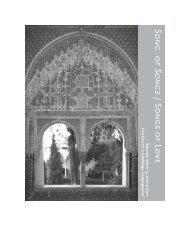BH1001, Guillaume Du Fay: Motets - Blue Heron
BH1001, Guillaume Du Fay: Motets - Blue Heron
BH1001, Guillaume Du Fay: Motets - Blue Heron
Create successful ePaper yourself
Turn your PDF publications into a flip-book with our unique Google optimized e-Paper software.
10<br />
the latter possibility is a requirement for those<br />
works in which one line occasionally divides<br />
into two or more, as occurs in the Sanctus<br />
“Papale” and many of <strong>Du</strong> <strong>Fay</strong>’s motets, although<br />
not those recorded here. Sacred music was<br />
normally sung a cappella, but some sort of<br />
instrumental participation, most likely by the<br />
organ or some sort of brass instrument, seems<br />
to have been possible, especially on occasions<br />
of more pomp and splendor. 9 As a rule, the top<br />
parts of sacred polyphonic works carry text in<br />
the sources; lower, untexted parts might be<br />
texted by the singer or, it has been suggested,<br />
the singer might simply vocalize wordlessly. 10<br />
We have availed ourselves of all these options<br />
for the sacred music on this recording. The<br />
three isorhythmic motets and the Sanctus are<br />
sung by two voices per part (in some places<br />
three), and the lower voices of the Sanctus,<br />
which are erratically texted in the sources, have<br />
been underlaid with text. The untexted tenor<br />
of Apostolo glorioso is played on trombone, as<br />
are the tenor and contratenor of Rite majorem;<br />
the two tenors of Ecclesie militantis are vocalized<br />
by singers doubled by slide trumpet and<br />
trombone. In the hymns, the plainchant is<br />
sung by an ensemble of men, the polyphonic<br />
verses by soloists, with text added to tenor and<br />
contratenor. The three parts of Flos florum, all<br />
texted in the sources, are sung by soloists.<br />
A lively discussion of the historically appropri-<br />
ate performance of the polyphonic chanson<br />
repertoire took place in the scholarly literature<br />
from the 1970s through the 1990s, with the<br />
most significant contributions being made<br />
by Howard Mayer Brown, David Fallows, and<br />
Christopher Page. 11 It is clear that secular songs<br />
were normally performed one to a part, and<br />
that the top part, invariably texted in the<br />
musical sources, was intended to be sung;<br />
the questions concern lower, untexted parts.<br />
Were they sung, or were they played on instruments,<br />
and if so, which? If sung, did the singers<br />
vocalize or add text? Brown, drawing on<br />
artistic representations and literary sources,<br />
argued for the participation of instruments<br />
as a option available throughout the period,<br />
while Fallows, examining the evidence from<br />
archives and elsewhere of ensembles specifically<br />
linked to the performance of polyphony,<br />
and Page, supported mostly by his reading<br />
of literary accounts, lent strength to the idea<br />
that secular polyphony was most often performed<br />
by voices alone; they proposed wordless<br />
vocalization as a viable option for the<br />
performance of untexted lines. Meanwhile,<br />
Dennis Slavin showed that, in the case of a<br />
song with multiple sources, one source might<br />
have an untexted tenor, while in another the<br />
part would receive text, raising the possibility<br />
of treating other untexted tenors similarly,<br />
breaking ligatures and adding repeated notes<br />
as necessary to accomodate the words, as the<br />
fifteenth-century scribes did.



